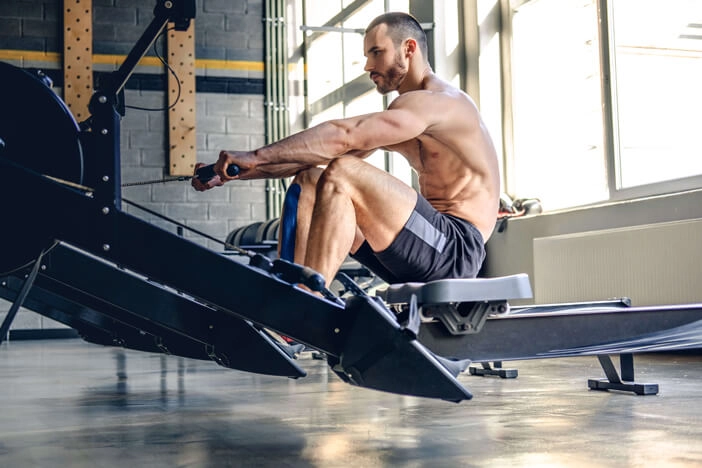Rowing on the rows machine for beginners

- Rowing on the rows machine: targeted muscle groups
- Correct technique when using the rows machine
- Recommended weight for rowing on the machine
- Necessary equipment
- Variations on the rows machine
- Typical errors when using the rows machine
- In which training plans does the rows machine appear?
- Frequently asked questions
Rowing on the rows machine: targeted muscle groups
The rows machine helps beginners to avoid most of the common errors that occur when rowing with a barbell or on the cable pull. With rowing exercises you can work on the depth and density of your back.
Primary muscle groups used:
- The broad back muscle
- Posterior part of the deltoid muscle
- Trapezius
Secondary muscle groups used:
- Biceps
- Arm flexors (Brachialis)
The exercise is therefore suitable for extensive back training.
Correct technique when using the rows machine
First sit upright on the rows machine. Make sure that the seat is adjusted to the correct height. This is where your upper and lower legs are at a 90° angle to each other when your feet are completely flat on the floor. Press your upper body against the chest pad with your chest outstretched. Now hold the handle with both hands and tense your back. As you exhale, pull the handle as far back as possible at just below chest height. Keep your elbows close to your body and your chest in the same position on the chest pad. The aim is to pull the handle so far back that your shoulder blades touch each other (although in practice limited mobillity usually doesn’t allow for this). As you inhale bring your arms back to the starting position.
Recommended weight for rowing on the machine

When using the rows machine, start with a light weight and increase the weight with each set if possible.
Necessary equipment
You need a rows machine, so unless you have one at home, you will need to go to the gym.
Variations on the rowing machine
There is little room for variation on the rowing machine. However, you can also row using free weights or the cable pull.
Typical errors when using the rows machine

- Moving your upper body: moving your upper body whilst rowing will relieve your muscles, but in return increase the strain on your spine. This reduces the effectiveness of the exercise and increases the risk of back injury. Your chest should therefore remain firmly against the pad at all times and the movement should come exclusively from your arms and upper back.
- A hunched back: this will make the exercise less effective and increase the risk of injury. Keep tension in your back to keep it straight
In which training plans does the rows machine appear?
Learn more about back exercises and how you can incorporate rows in our back training article.
Frequently asked questions
- Moving your upper body: moving your upper body whilst rowing will relieve your muscles, but in return increase the strain on your spine. This reduces the effectiveness of the exercise and increases the risk of back injury. Your chest should therefore remain firmly against the pad at all times and the movement should come exclusively from your arms and upper back.
- A hunched back: this will make the exercise less effective and increase the risk of injury. Keep tension in your back to keep it straight
There is little room for variation on the rows machine. However, you can also row using free weights or the cable pull.
The rows machine helps beginners to avoid most of the common errors that occur when rowing with a barbell or on the cable pull. With rowing exercises you can work on the depth and density of your back.
Primary muscle groups used:
- The broad back muscle
- Posterior part of the deltoid muscle
- Trapezius
Secondary muscle groups used:
- Biceps
- Arm flexors (Brachialis)
